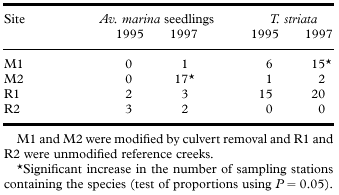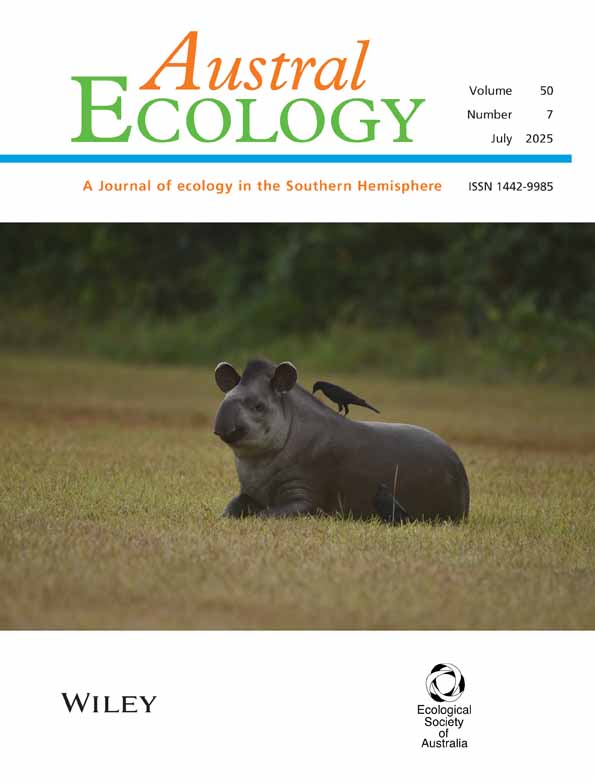Changes in productivity of the saltmarsh mosquito, Aedes vigilax (Diptera: Culicidae), and vegetation cover following culvert removal
Abstract
Changes following culvert removal in the production of the saltmarsh mosquito, Aedes vigilax (Skuse), and the cover and occurrence of halophytes were investigated on Kooragang Island, New South Wales, Australia. Mosquito eggshells were collected from saltmarsh soil and used as an index of mosquito production. Saltmarsh bordering each of four tidal creeks was sampled prior to the removal of culverts from two of these creeks in 1995. All creeks were resampled two years later. In most instances, eggshell densities decreased significantly at saltmarshes affected by culvert removal, with relatively small change at reference saltmarshes. However, oviposition by Ae. vigilax was initiated in upland areas following culvert removal at one site. Sarcocornia quinqueflora cover decreased significantly at sites affected by culvert removal relative to reference sites. The cover of Sporobolus virginicus and frequency of occurrence of Triglochin striata increased significantly at one modified site, while the frequency of occurrence of Avicennia marina seedlings increased significantly at the other modified site. We suggest that culvert removal and other alterations intended to increase tidal flushing will lead to vegetation patterns and mosquito eggshell densities that typically occur in the more frequently inundated saltmarsh–mangrove complex.
INTRODUCTION
Saltmarshes have long been recognised as important to the health and productivity of estuaries (e.g. Odum 1961, 1980; Montague et al. 1981; Pomeroy et al. 1981; Vernberg 1993). Despite this, many saltmarshes have been lost or degraded. For example, over 80% of saltmarsh habitat in the Sydney region, Australia, has been lost since European settlement (Stricker & Adam 1989). In 1985, there was only an estimated 57 km2 of saltmarsh in New South Wales (West et al. 1985), giving remaining remnants high conservation value (Clarke 1993). Many existing saltmarshes are degraded due to tidal restrictions caused by the presence of structures such as culverts (e.g. Burdick et al. 1997). Recognition of the extent of destruction and degradation of saltmarshes has been followed by an increase in the implementation of recommendations resulting from wetland rehabilitation projects (Streever 1997).
Restoring the hydrology of saltmarshes is an important step for effective rehabilitation of these wetlands (Coats et al. 1989; Roman et al. 1995; Brockmeyer et al. 1997; Burdick et al. 1997; Turner & Lewis 1997). This usually involves increasing tidal flushing by removing or modifying structures that impede tidal flow, such as culverts, floodgates and dikes (Williams & Watford 1997). However, except for marshes principally modified for mosquito control, little is known about the impact of culvert removal and subsequent improved tidal flushing on saltmarsh mosquito production.
Aedes vigilax is the most common saltmarsh mosquito in Australia, and is of most concern in coastal regions of Queensland and New South Wales as the principle vector of Ross River virus, the aetiological agent of epidemic polyarthritis (Dale 1993; Russell 1993). Aedes vigilax normally lay eggs in small cracks in soil on vegetated, sloping banks of intermittently flooded depressions (Kerridge 1971; Sinclair 1976; Dale et al. 1986; Turner & Streever 1997a). A few eggs are also laid on stems of saltmarsh plants and on mangrove pneumatophores (Kay & Jorgensen 1986; Gislason & Russell 1997). The presence and density of Aedes eggs and eggshells can be used to identify oviposition sites and give an estimate of potential and past mosquito production (Lopp 1957; Ritchie et al. 1992; Ritchie 1994). Aedes eggshells do not shift from the site of oviposition under normal conditions, although simulated erosion has been shown to displace them (Ritchie et al. 1992). Therefore, eggshells generally accumulate at or near the site of oviposition (Lopp 1957; Scotton & Axtell 1979; Kay & Jorgensen 1986). In the present study, we utilized changes in the density of Ae. vigilax eggshells to detect changes in mosquito production following the removal of culverts.
The Kooragang Wetland Rehabilitation Project (KWRP) was founded in 1991 to mitigate for losses of wetland habitat on Kooragang Island, New South Wales, Australia. A major objective of KWRP was to improve fisheries habitat (Shortland Wetlands Centre Ltd 1992), although some concern was raised regarding the effect of wetland rehabilitation on mosquito abundance. Rehabilitation was initiated with the replacement of two culverts with bridges on the western portion of Kooragang Island in 1995. Culvert replacement resulted in improved tidal flushing (Streever et al. 1996) and subsequent expansion of saltmarsh (MacDonald 1996; Streever & Genders 1997). The aim of this paper was to determine the effect of culvert removal on mosquito production and wetland vegetation. Specifically, reference sites were compared with sites modified by culvert removal in terms of: (i) changes in the abundance of Aedes vigilax eggshells; (ii) changes in cover of the saltmarsh plants, Sarcocornia quinqueflora and Sporobolus virginicus; and (iii) changes in the occurrence of Triglochin striata shoots and Avicennia marina seedlings. Also, the appearance of eggshells in upland pasture killed by increased tidal inundation is described and differences in eggshell abundance between different vegetation types were determined.
METHODS
Study site
Kooragang Island (32°51′S 151°43′E) is a partially reclaimed landmass of 2560 ha located near the mouth of the Hunter River, Newcastle, Australia (Fig. 1). Mean tidal range at the river mouth is 1.05 m and tidal influence extends for ~ 50 km upstream (Streever et al. 1996). Mean annual rainfall at Nobby’s Signal Station (~ 12 km from the study site) is 1142 mm with highest rainfall occurring from March to June and lowest falls from August to November. Mean daily maximum air temperature ranges from 24.6°C in January to 16.7°C in July (Bureau of Meteorology 1995). The southeastern portion of Kooragang Island has been reclaimed for industrial development, while the National Parks and Wildlife Service (New South Wales) gazetted the northeastern portion of the island as a Nature Reserve in 1983. The western side has been managed by KWRP for wetland habitat rehabilitation since 1995, but the grazing of cattle was the main land use up until that time. Although the relative relief of saltmarsh on the island is only about 70 cm (Turner & Streever 1997a), livestock and vehicles have disturbed its surface in some areas. Pasture development and construction of roads on the western end of Kooragang Island commenced in the mid-1850 s and appear to impede the inundation of saltmarsh in many areas (Williams et al. 1995).
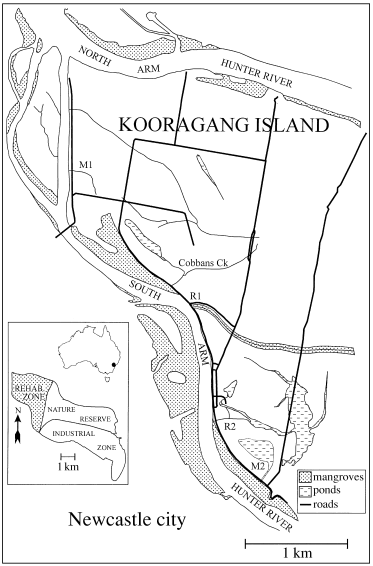
. Sampling locations for Aedes vigilax eggshells and vegetation within the rehabilitation zone (shaded portion of inset) on Kooragang Island, New South Wales. Samples were collected from saltmarsh before and two years after culvert removal. Culverts were removed from M1 and M2 whereas the culverts of R1 and R2 remained intact. Map modified from Turner & Streever (1997a).
Sarcocornia quinqueflora (Bunge ex Ungen-Sternberg) A. J. Scott, Sp. virginicus (L.) Kunth, T. striata Ruiz and Pavon, and Suaeda australis (R. Br.) Moq. are the most common halophytes on Kooragang Island. Sarcocornia quinqueflora and Sp. virginicus are usually the dominant species. The exotic Juncus acutus L. and native J. kraussii Hochst. are found in elevated areas often associated with Sp. virginicus and pasture-saltmarsh boundaries (Outhred & Buckney 1983). Mangrove vegetation on the island is dominated by Av. marina (Forsk.) Vierh. with some Aegiceras corniculatum (L.) Blanco present (Outhred & Buckney 1983). Mangrove communities replaced some saltmarsh between 1954 and 1982 (Buckney 1987). Common pasture grasses include Stenotaphrum secundatum (Walt.) Kuntze, Pennisetum clandestinum Hochst. ex Chiov., and Cynodon dactylon (L.) Pers. (Streever & Genders 1997). Saltmarsh vegetation at the study site occur on soil dominated by clay (55–75%) and silt (10–40%) (Nelson 1994).
Mosquito eggshell and vegetation sampling
Saltmarsh bordering four creeks (Fig. 1) was sampled to determine eggshell density and vegetation cover in June 1995, in the manner described below. These creeks are hereafter referred to as M1, M2, R1, and R2. Each creek had a culvert near its discharge point into the lower Hunter River. Culverts were removed from two ‘modified’ creeks (M1 and M2) in July and August 1995, respectively (Streever et al. 1996). Two reference creeks (R1 and R2), where culverts were left intact, were also sampled. All sites were re-sampled in June and July 1997.
Mosquito eggshells were sampled and percentage cover of Sa. quinqueflora and Sp. virginicus assessed immediately before culvert removal and two years after culvert removal. On each occasion, sampling was carried out at 40 1 m2 sampling stations at each creek. Random compass bearings (0–360°) and distances (1–50 m) were used to position sampling stations within the marsh. All sampling stations were marked with numbered wooden stakes. A 1 m2 quadrat was placed onto the ground with the stake in one corner. The angle of the quadrat relative to north was recorded so that the quadrat could be repositioned in 1997. Each sampling station was divided into 16 subquadrats. The percentage cover of vegetation was visually estimated for Sa. quinqueflora and Sp. virginicus in each subquadrat and averaged to give an estimate for the 1 m2 area. A 15 cm3 soil core was extracted from each subquadrat at each sampling station and combined to form one sample. Soil cores were 2.9 cm in diameter and taken to a depth of 2.2 cm. Soil samples were transported to the laboratory and refrigerated at 3°C for at least 3 weeks to reduce the likelihood of hatching during processing (Kerridge 1971). Eggs and eggshells of Ae. vigilax do not occur in large numbers on stems of saltmarsh plants and mangrove pneumatophores (Kay & Jorgensen 1986; Gislason & Russell 1997). These oviposition substrates were not sampled as part of the current study.
Soil samples were subsampled prior to the isolation of eggshells using a water flotation procedure (Ritchie & Jennings 1994; Turner & Streever 1997a,b). Twenty percent of each soil sample was processed. Eggshells were counted under a dissecting microscope and determined as those belonging to Ae. vigilax by comparison with photos by Linley et al. (1992), Kay & Jorgensen (1986), and S. A. Ritchie (unpubl. data). Hatched eggshells were identified by the presence of an eclosion line, indicating successful hatching of larvae. Whole eggs were intact, cylindrical, black or dark brown in colour, with the potential to produce larvae. Unhatched eggshells are the flattened, discoloured remnants of whole eggs having no potential to produce larvae.
Low densities of T. striata and Av. marina precluded a precise estimate of ground cover of these species. Therefore, changes in the occurrence (presence and absence) of T. striata shoots and Av. marina seedlings was determined at all 160 sampling stations before and two years after the removal of culverts.
Upland pasture became flooded by tides following culvert removal at both modified sites. At M2, high densities of mosquito larvae were present in depressions formed among pasture during the summer of 1996–97. Larvae may have dispersed into these depressions from nearby saltmarsh following tidal inundation, so eggshell sampling was carried out to determine if oviposition was occurring at these depressions. Ten soil samples were collected from each of three sites at M2 in August 1997. Two sites consisted of dead or dying buffalo grass, St. secundatum, at the edge of two depressions. The third site consisted of healthy St. secundatum in a nearby area. Each soil sample consisted of two contiguous 15 cm3 soil cores taken to a depth of 2.2 cm. Eggshells were separated from soil particles with water flotation, as described above.
Eggshell densities were compared between vegetation categories, based on samples collected from 157 sampling stations in 1995. Three sampling stations were devoid of vegetation so were excluded from analysis. Categories include Sa. quinqueflora, Sp. virginicus, a mixture of these two, and T. striata. Triglochin striata was thought to reflect waterlogged soil conditions, and as such was treated as a separate category although it co-occurred with other species.
Data analyses
The effect of culvert removal on: (i) abundance of Ae. vigilax eggshells, (ii) percentage cover of Sa. quinqueflora, and (iii) percentage cover of Sp. virginicus was determined with single-factor analysis of variance (ANOVA) and Tukey’s multiple comparison tests. Response variables were calculated by subtracting data collected from each sampling station in 1997 from those collected in 1995. Therefore, positive values indicate an increase and negative values a decrease in the response variable between the years. For the analysis of eggshells, whole eggs, hatched eggshells, and unhatched eggshells were combined and were used to determine differences in the extent of change between the creeks. To satisfy the assumptions of ANOVA (i.e. normality of data and equality of variances), eggshell data were transformed using log10 (y + 1), and percentage cover data were converted to proportions (p) and transformed using arcsin√p (Zar 1984). Transformations were carried out prior to the calculation of differences between years. The logarithmic transformation of eggshell data allowed an assessment of relative changes, as opposed to absolute changes, in eggshell abundance between the creeks. This is a useful property of the transformation, because the sites and sampling stations varied considerably in their eggshell density. Raw means are displayed in figures because differences cannot be back-transformed.
A test of proportions was used to determine changes in the occurrence of T. striata and Av. marina at each creek following culvert removal. For the study of eggshells in tidally flooded pasture at M2, no eggshells were found at the site with healthy pasture. Therefore, a t-test for unequal variances was used to determine differences in eggshell density between the two depressions. A Kruskal–Wallis test and a multiple comparison test (Conover 1980) were used to locate differences in eggshell density between vegetation categories. No standard transformation adequately equalised variances. Statistical analyses were carried out with STATISTICA™ (Statsoft 1995).
RESULTS
Changes in the abundance of Ae. vigilax eggshells following culvert removal
A total of 27 157 eggs and eggshells of Ae. vigilax was collected from the 160 sampling stations over both years. Mean eggshell abundance at each creek, before and after culvert removal, is presented in Table 1. Eggshell abundance varied considerably between sampling stations, ranging from zero to 3115 eggshells per sample. Seventeen percent of samples contained no eggshells, whereas two percent contained more than 1000 eggshells. Additionally, hatched eggshells comprised 84.5% of the total, ranging from 79.8% to 87.2% across sites and sampling periods. Unhatched eggshells comprised 14.7% of the total, ranging from 11.9% to 19.3%. Whole eggs made up less than 1% of the total, ranging from 0.2% to 3.0%.
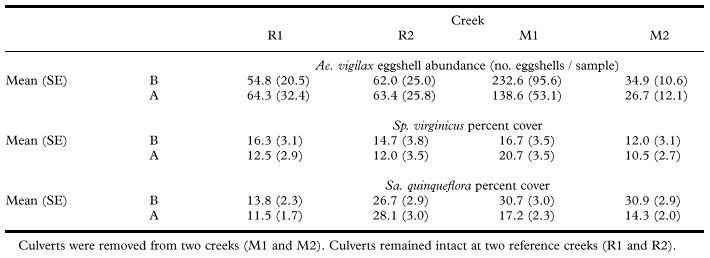
There were significant differences between creeks in change in abundance of eggshells following culvert removal (single-factor ANOVA, F3,156 = 9.72, P < 0.0001). The mean number of eggshells decreased significantly at M2 compared to reference creeks, R1 and R2 (Fig. 2). The number of eggshells at M1 decreased significantly relative to R2 but not R1. There was no significant difference in the magnitude of change when M1 was compared to M2, and when R1 was compared to R2 (Fig. 2).
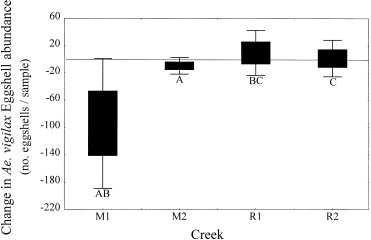
. The mean change in abundance of Aedes vigilax eggshells, collected from the saltmarsh of four creeks on Kooragang Island, New South Wales. Samples were collected before and two years after culvert removal. Creeks with the same letter are not significantly different. Culverts were removed from M1 and M2 whereas the culverts of R1 and R2 remained intact. Boxes are 1 SE, whiskers are 2 SE, and n = 40 for each creek.
Changes in vegetation following culvert removal
Percent covers of Sa. quinqueflora and Sp. virginicus, before and after culvert removal, are presented in Table 1. Mean cover ranged from 10.5% for Sp. virginicus to 30.9% for Sa. quinqueflora (Table 1). In 1995, 31% of all sampling stations had total vegetation cover (Sa. quinqueflora & Sp. virginicus combined) greater than 50% and 7.5% of sampling stations had greater than 75% cover. All except three sampling stations had some degree of vegetation cover. Sarcocornia quinqueflora occurred most frequently, being present in 90% of sampling stations. Sporobolus virginicus occurred in 67% of the sampling stations.
There were significant differences between creeks in the change of Sa. quinqueflora cover between sampling periods (single-factor ANOVA, F3,156 = 13.72, P < 0.0001). Mean cover decreased significantly at both M1 and M2 relative to R1 and R2 (Fig. 3). Mean cover decreased to the same extent at M1 and M2 (Fig. 3).
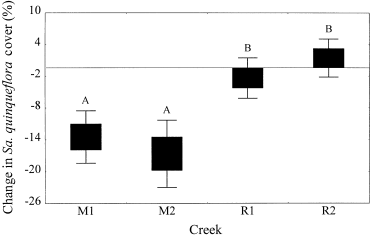
. The mean change in percentage cover of Sarcocornia quinqueflora, collected from the saltmarsh of four creeks on Kooragang Island, New South Wales. Samples were collected before and two years after culvert removal. Culverts were removed from M1 and M2 whereas the culverts of R1 and R2 remained intact. Creeks with the same letter are not significantly different. Boxes are 1 SE, whiskers are 2 SE, and n = 40 for each creek.
There were also significant differences between creeks in the change of Sp. virginicus cover between sampling periods (single-factor ANOVA, F3,156 = 6.51, P < 0.0004). Mean cover increased significantly at M1 relative to both R1 and R2 (Fig. 4). Change in cover at M2 could not be statistically separated between the reference creeks and M1.
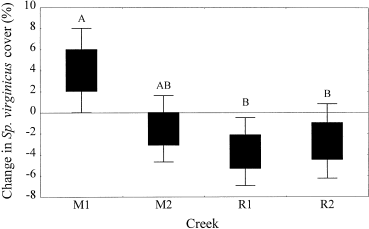
. The mean change in percentage cover of Sporobolus virginicus, collected from the saltmarsh of four creeks on Kooragang Island, New South Wales. Samples were collected before and two years after culvert removal. Culverts were removed from M1 and M2 whereas the culverts of R1 and R2 remained intact. Creeks with the same letter are not significantly different. Boxes are 1 SE, whiskers are 2 SE, and n = 40 for each creek.
Avicennia marina seedlings at M2 and T. striata at M1 increased significantly (test of proportions, P < 0.05) in occurrence following culvert removal (Table 2). No significant changes in occurrence were noted at the two reference creeks. Prior to culvert removal, mangrove seedlings occupied none of the selected sampling stations at M2. Two years later, 17 of 40 sampling stations (42.5%) contained Av. marina seedlings. Seedlings established on the mudflat of the large pond at M2 (Fig. 1) and among the surrounding saltmarsh. Triglochin striata occurrence increased from 15% to 37.5% at M1 (Table 2). Cover of both species was generally less than 5%.
Occurrence of Ae. vigilax eggshells in tidally flooded pasture
No eggshells were recovered from soil samples collected from healthy pasture. However, both depressions flooded by high tides following culvert removal had moderate eggshell densities. Mean (± 1 SE) eggshell density did not differ significantly between site 1 (38.20 ± 743.06) and site 2 (12.50 ± 44.47) (t = 2.23, d.f. = 10, P = 0.38).
Eggshell densities associated with different vegetation species
Eggshell density differed significantly between vegetation categories (Kruskal–Wallis test, H = 8.45, n = 157, P = 0.037). Lower eggshell numbers were associated T. striata compared to mixed Sa. quinqueflora and Sp. virginicus vegetation (P < 0.05) or stands of S. quinqueflora (P < 0.05) (Fig. 5). Eggshell abundance from pure stands of Sp. virginicus could not be statistically separated from those recorded from T. striata or the other two categories.
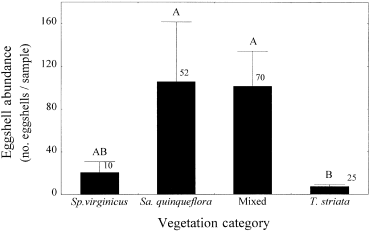
. The mean abundance of hatched Aedes vigilax eggshells in association with different saltmarsh plant species, based on samples collected prior to culvert removal on Kooragang Island, New South Wales. The mixed category is a composite of Sarcocornia quinqueflora and Sporobolus virginicus. Categories with the same letter are not significantly different in their mean eggshell abundance. Error bars are 1 SE and sample sizes for each vegetation category are indicated.
DISCUSSION
The effective control of mosquitoes (Culicidae) is an important consideration for the conservation and rehabilitation of saltmarshes (Carlson et al. 1991; Streever 1997; Turner & Streever 1997a). Enhancing the tidal inundation of saltmarsh usually results in significantly reduced mosquito production, especially in cases where projects specifically target mosquito breeding sites (Dale et al. 1993; Kramer et al. 1995). However, little is known about the effect of simply removing barriers to tidal inundation, such as culverts, on the production of mosquitoes in otherwise unmanaged marshes. The present study shows that mosquito oviposition was significantly reduced in saltmarsh affected by culvert removal. Reduced oviposition was probably mediated by changes to the flooding frequency of saltmarsh depressions, the principal oviposition habitat of Ae. vigilax (Kerridge 1971; Turner & Streever 1997a). The production of Aedes mosquitoes on saltmarshes is mainly associated with depressions flooded by spring tides or high tides supplemented with rainfall (Provost 1977). On Kooragang Island, high densities of Ae. vigilax eggshells were found in soil around vegetated depressions that were remote from sources of tidal inundation (Turner & Streever 1997a). Few eggshells were recovered from the regularly inundated, sparsely vegetated areas close to drainage lines. Similarly, Balling & Resh (1983) suggested that Aedes mosquitoes in San Francisco Bay only breed in ponds above a certain elevation which was related to the frequency of tidal inundation. In the present study, tidal ranges within the creeks have increased at sites where culverts were removed (Streever et al. 1996). If this increase is extrapolated to the surrounding saltmarsh, then an increase in flooding frequency may have made many of the existing depressions unsuitable for oviposition. Increased flooding frequency probably enhanced wetness and waterlogging of the substrate, a situation known to reduce the attractiveness of the oviposition substrate in Aedes mosquitoes (Kerridge 1971; Horsfall et al. 1975). Other factors associated with increased tidal exchange that may have inhibited oviposition include increased fish access (Ritchie & Laidlaw-Bell 1994; Williams et al. 1995) or changes to soil microbial populations known to act as oviposition attractants (Hazard et al. 1967; Wallace 1996).
Oviposition shifted from saltmarsh to depressions on upland pasture at M2 following culvert removal. St. secundatum characterised the pasture of these depressions and formed a thick, matted, detrital layer in some places. Detrital material on the oviposition surface has been demonstrated to be attractive to Aedes mosquitoes (Horsfall et al. 1975; Ritchie & Johnson 1991) and may maintain the moderate to high substrate moisture levels required for oviposition (Knight & Baker 1962; Strickman 1980). Pasture killed by tidal inundation will probably be replaced by saltmarsh vegetation (Streever & Genders 1997). The establishment of Sa. quinqueflora was noted at one of the depressions. Moreover, although oviposition was reduced in the existing saltmarsh, new oviposition sites were created at M2 on what had been pasture prior to culvert removal.
Changes to saltmarshes through hydrologic modification significantly influence plant composition and cover. For example, increased tidal exchange between impounded marshes and nearby estuaries may shift plant communities from freshwater to that characteristic of brackish marshes (Rey et al. 1990; Sinicrope et al. 1990; Brockmeyer et al. 1997). In the present study, reductions in Sa. quinqueflora cover occurred at both sites affected by culvert removal. Increased inundation may reduce photosynthesis by interfering with light supply and gas exchange of herbaceous species such as Sa. quinqueflora (Clarke & Hannon 1969; Mahall & Park 1976). Tidal scour was evident in some areas of M2 and coverage of stems with sediment may clog stomates (Clarke & Hannon 1969). The increase in Sp. virginicus at M1 may be due to increased soil moisture levels following culvert removal. Sp. virginicus typically occurs at lower elevations than Sa. quinqueflora on Kooragang Island (Zedler et al. 1995) and monospecific stands of this species occur in regularly inundated areas along main tidal channels (Winning 1991). Zedler et al. (1995) also suggested that Sp. virginicus might have a competitive advantage over Sa. quinqueflora at lower elevations, so in the case of M1, increased tidal inundation may shift the competitive advantage toward Sp. virginicus.
Overall reductions in the cover of saltmarsh plants may have contributed to reduced oviposition because eggshell densities are correlated with the presence and percentage coverage of these plants (Kerridge 1971; Horsfall et al. 1975; Dale et al. 1986; Turner & Streever 1997a). However, as indicated by the study of oviposition in tidally flooded pasture, Ae. vigilax will lay eggs in the absence of saltmarsh plants, suggesting their presence is of secondary importance for oviposition.
There was a marked increase in the establishment of Av. marina seedlings following culvert removal at M2. The landward migration of Av. marina is thought to be limited by large variations in salinity (Clarke & Hannon 1969). Therefore, the amelioration of variation in soil salinity brought about by increased tidal inundation may have contributed to seedling establishment. Removal of the physical barrier created by culverts may have also increased the number of mangrove propagules reaching the saltmarsh on the landward side of the culvert. Ae. vigilax larvae are occasionally found among poorly flooded mangrove swamps, with some eggs being laid on mangrove pneumatophores (Kay & Jorgensen 1986; Gislason & Russell 1997). However, mangroves at M2 have established under well flooded and freely draining conditions that are characteristic of the lower intertidal zone along the river bank. These conditions are not suitable for oviposition as suggested by the decrease in eggshell density at this creek following culvert removal.
The increase in occurrence of T. striata at M1 may be due to poor drainage following flood tides. Triglochin striata typically occurs in waterlogged soils (Adam & Hutchings 1987; Adam et al. 1988), and where there is disturbance by livestock (Zedler et al. 1995). Cover of T. striata increased at Cobbans Creek on Kooragang Island after its culvert washed out in 1990 (Zedler et al. 1995). Eggshell densities were found to be significantly lower at sampling stations containing T. striata than those associated with Sa. quinqueflora. Low eggshell densities and waterlogged conditions associated with T. striata indicate that locations with T. striata may be suboptimal for oviposition by Ae. vigilax. On Kooragang Island, significantly fewer eggshells were recovered from unvegetated soil, suggesting these sites are also unattractive to gravid mosquitoes (Turner & Streever 1997a).
This paper provides some insight into the potential effects of culvert removal on vegetation and mosquito production that should be considered in future estuarine wetland rehabilitation projects that rely on improved tidal flushing.
Acknowledgements
We thank Pat Dale and Brian Conroy for assistance and support during this study. We appreciate financial assistance provided by BHP–Newcastle Steelworks. Statistical advice provided by Matthew Zack and Kathy Beal is appreciated. KWRP provided assistance and encouragement for the duration of this study.



